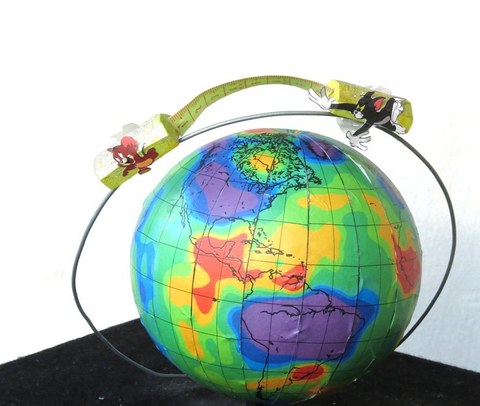Mar 16, 2022
The attractive force of ice: 20 years of satellite measurements and their analysis in Dresden

Künstlerische Interpretation der beiden GRACE-Satelliten Artist's impression of the two GRACE satellites as Tom & Jerry, depicted on a doctoral cap.ur für Geodätische Erdsystemforschung.
Twenty years ago, on 17 March 2002, the German-American satellite mission GRACE was launched to measure the Earth's gravitational pull with high precision. Scientists from TU Dresden have been using this data from the very beginning. From small changes in the Earth's gravitational pull, they determine mass changes in the ice sheets in Greenland and Antarctica. Data series of these ice mass changes are provided by the Institute of Planetary Geodesy at TU Dresden on behalf of the European Space Agency ESA.
"GRACE" stands for "Gravity Recovery and Climate Experiment". The GRACE mission ended in 2017 and has been continued by the "GRACE Follow-On" mission since 2018. GRACE and GRACE Follow-On work according to the same principle: twin satellites follow each other in their orbit at a distance of about 200 km. The fluctuations of this distance are measured, to an accuracy of one thousandth of a millimetre. Since the fluctuations in this distance are caused by the irregularities of the Earth's gravitational pull, it can be determined to small detail. The direct measurements, the raw data so to speak, are processed by the colleagues at the Helmholtz Centre Potsdam German Research Centre for Geosciences, among others. They thus provide the input datasets for the analyses of the Dresden geodesists.
From 2002 to 2021, the Greenland Ice Sheet lost about 5000 billion tonnes of mass, the Antarctic Ice Sheet about 1800 billion tonnes. One billion tonnes correspond to the mass of one cubic kilometre of water. The meltwater increases the water masses of the ocean and is responsible for about a quarter of the global sea level rise.
Quotes
Martin Horwath, Professor of Geodetic Earth System Research, explains:
"Measurements provides facts. Determining ice mass changes with the help of the gravitational force is a unique method because we can't actually miss any changes. Combined with other satellite methods, such as measuring ice surface heights and flow velocities, this method provides a detailed picture of current ice sheet changes."
"The decrease of ice on the continents leads to the increase of water masses in the oceans. And we can also measure these using their gravitational effects."
"Years of development went into the methodology to analyse the GRACE data. And the results are freely accessible on our data portal, for students as well as for climate researchers."
